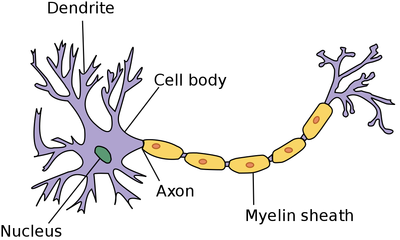Skin Cell Adaptation. Dendrites are also useful to the nerve cell as each dendrite can receive signals from other neurones and this means that one.

Overview Of Neuron Structure And Function Article Khan Academy
The sperm cell has primarily adapted to its intended function through a variety of anatomical changes.
. Nerve cells have very long axons being they can deliver messages for a longer time before passing it on to the next cell which makes this process significantly faster. The axon is insulated by a fatty myelin sheath - the fatty sheath increases the speed of the nerve impulses. This increases the speed of transmission by forcing the impulse to jump between gaps in the sheath known as nodes of ranvier rather than passing along the full.
Secondly how are muscle cells adapted to their function. The nerves cells are rather long which enables communication with distant body parts. One of the most crucial adaptations that sperm have evolved is their flagella which propel them as they travel toward unfertilized ova.
They are adapted to carry electrical impulses from one place to another in a stimulated neuron an electrical nerve impulse passes along the axon. They contain protein fibres that can contract when energy is available making the cells shorter. A cone cell has a pigment called iodopsin.
According to Molecular Biology of the Cell sperm have also lost a number of organelles because such organelles are not. The specialization of neurons also known as neurons or nerve cells is carrying messages within the brain. Another adaptation is the myelin sheath it makes the cell very thick and the thicker they are the faster the impulses are transmitted across them.
A nerve cell has several adaptations that allow it to carry out needed functions such as its myelin sheath projections and divisions and its extremely long length. Nerve cell have very long axons which can take the message a very long way before passing it on to the next cell this makes it quicker. The nerve cell is covered with a fatty sheath which insulates the nerve cell and speeds up the nerve impulse.
What function does a Specialised cell have. The sheath insulates the axon and makes the electrical impulse jump increasing the speed of transmission. Despite the specific molecular morphological and functional features of any particular nerve cell type the basic structure of neurons resembles that of other cells.
Specialised cells are cells designed to carry out a particular role in the body such as red blood cells which are designed to carry oxygenNerve cells help contraction of muscles or the relaxation of muscles according to what specific job you need them to do. There are three different types of these pigments that are sensitive to red blue or green wave lengths of. How different types of plant cells are adapted to their function.
Feb 13 2018. Myelin surrounding the axon of a neuron acts as an insulator. Nerve cells are also known as neurons.
The axon the long thin part of the neurone along which the impulse passes is covered in a fatty myelin sheath which acts as an electrical insulator. To acheive these functions nerve cells have several adaptations. Nerve cells have many adaptations in order to perform their functions.
Although neurons do have some similar features as other cells in the human body their specialized features enable them to carry out the communication within the brain which is their unique function. Neurons communicate with each other as well as with other cells through electric signals nerve impulses which in turn allows effector organs to respond to the appropriate stimuli. They are adapted to carry electrical impulses from one place to another.
There are billions of nerve cells inside the human body. Nerve cells may be described as receivers and transmitters of information that allow. For example muscle cells bring parts of the body closer together.
Another adaptation is the myelin sheath it makes the cell very thick and the thicker they are the faster the impulses are transmitted across them. Nerve cells are called neurons. Nerve cells are also called neurons.
They have structures that are adapted for their function. Delivering a message to other nerves in different parts of the body is the basic function of the nerve cell. Has many nerves that allow you to sense your surroundings and allows you to hold and absorb many important nutrients.
Many cells are specialised. The sheath insulates the axon and makes the electrical impulse jump increasing the speed of. Nerve Cell Adaptation.
Essentially nerve cells also known as a neurons are the active component of the nervous system. Thus each nerve cell has a cell body containing a nucleus endoplasmic reticulum ribosomes Golgi apparatus mitochondria and other organelles that are essential to the function of all cells Figure 13. An axon a single nerve fibre that carries nerve impulses away from a.
The dendrites allow for communication with other neurons.


0 Comments